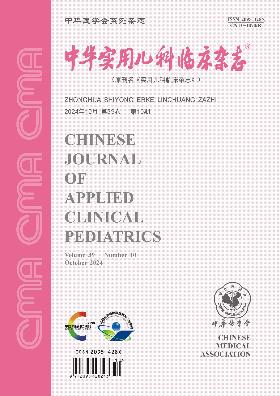Modification and significance of histone acetylation associated with interleukin-4 gene in pediatric Kawasaki disease
Q4 Medicine
引用次数: 0
Abstract
Objective To investigate the histone acetylation of interleukin-4(IL-4) gene and its roles in immunological pathogenesis of Kawasaki disease (KD). Methods Thirty-six children with KD and 28 age-matched healthy children in Shenzhen Children′s Hospital from October 2016 to December 2018 were recruited in this study.Peripheral venous blood samples were collected from healthy controls (28 cases) and patients with KD during acute phase and 4 to 5 days after effective intravenous immunoglobulin (IVIG) treatment.Co-immunoprecipitation followed by real-time PCR was used to assess histone H4 acetylation levels of IL-4 promoter and Va enhancer, and binding abilities of p300 and CREB-binding protein (CBP) with promoter and Va enhancer of IL-4 gene in peripheral blood CD4+ T cells.Flow cytometry was performed to analyze the proportion of CD4+ IL-4+ T cells (Th2) and protein le-vels of phosphorylated signal transducer and activator of transcription 6 (pSTAT6), GATA binding protein 3 (GATA3), nuclear factor 1 of activated T cells(NFAT1), transforming growth factor-β receptor Ⅱ (TGF-βRⅡ), and phosphorylated L-type amino acid transporter 1(pLAT1). Quantitative real-time PCR was used to evaluate the transcription levels of IL-4, IL-5, IL-13, IL-4 receptor α (IL-4Rα), transforming growth factor-β receptor Ⅰ (TGF-βRⅠ) and sex-determining region Y(SRY)-box 4 (SOX4) in CD4+ T cells.Plasma concentrations of IL-4 and transforming growth factor-β(TGF-β) were measured by enzyme-linked immunosorbent assay. Results (1)Compared with control group, the proportion of Th2 cells, expression levels of Th2-associated cytokines (IL-4, IL-5 and IL-13) and histone H4 acetylation levels associating with IL-4 promoter and Va enhancer, increased remarkably during acute KD(all P<0.05), and restored after IVIG therapy(all P<0.05). Meanwhile, all the former items in KD patients with coronary artery lesions (CAL) were higher than those in patients with non-coronary artery lesions (NCAL) (all P<0.05). (2) Compared with control group, binding abilities of p300 and CBP with IL-4 promoter and Va enhancer in CD4+ T cells were up-regulated significantly during acute KD (all P<0.05), and decreased in varying degrees after IVIG treatment (all P<0.05). Positive correlations between binding abilities of p300 with IL-4 (promoter and Va enhancer) and the expression of IL-4 promoter and Va enhancer were detected in patients with acute KD (r=0.72, 0.43, all P<0.05). Furthermore, binding abilities of p300 and CBP with IL-4 promoter and Va enhancer in CAL group were higher than those in NCAL group (all P<0.05). (3) Compared with control group, patients with acute KD had remarkably increased plasma concentration of IL-4, and expression levels of IL-4Rα/STAT6/GATA-3 and pLAT1/NFAT1 in CD4+ T cells (all P<0.05), and significantly down-regulated plasma concentration of TGF-β and expression level of TGF-βRⅡ/TGF-βRⅠ/SOX4 (all P<0.05). All the items mentioned above restored in varying degrees after IVIG treatment (all P<0.05). Simultaneously, the 6 items aforementioned in CAL group were found to be higher than those in NCAL group (all P<0.05), while the latter four items were lower than those in NCAL group (all P<0.05). Conclusion Histone hyperacetylation of IL-4 gene may be related to immune dysfunction in patients with KD. Key words: Kawasaki disease; Type Ⅱ helper T cells; Cytokine; Histone acetylation; Immune组蛋白乙酰化与白细胞介素-4基因在小儿川崎病中的修饰及其意义
目的探讨白细胞介素-4(IL-4)基因的组蛋白乙酰化及其在川崎病(KD)免疫发病机制中的作用。方法选取2016年10月至2018年12月在深圳市儿童医院就诊的36名KD患儿和28名年龄相匹配的健康儿童。在急性期和有效静脉注射免疫球蛋白(IVIG)治疗后4至5天,从健康对照组(28例)和KD患者中采集外周静脉血样。采用免疫共沉淀和实时PCR技术检测外周血CD4+T细胞中IL-4启动子和Va增强子的组蛋白H4乙酰化水平,以及p300和CREB结合蛋白(CBP)与IL-4基因启动子和Va增强子的结合能力。流式细胞仪分析CD4+IL-4+T细胞(Th2)的比例以及磷酸化信号转导子和转录激活子6(pSTAT6)、GATA结合蛋白3(GATA3)、活化T细胞核因子1(NFAT1)、转化生长因子-β受体Ⅱ(TGF-βRⅡ)和磷酸化L型氨基酸转运蛋白1(pLAT1)的蛋白水平。采用实时定量PCR技术检测CD4+T细胞中IL-4、IL-5、IL-13、IL-4受体α(IL-4Rα)、转化生长因子-β受体Ⅰ(TGF-βRⅠ)和性别决定区Y(SRY)-box4(SOX4)的转录水平。采用酶联免疫吸附法测定血浆IL-4和转化生长因子-β(TGF-β)浓度。结果(1)与对照组相比,Th2细胞比例、Th2相关细胞因子(IL-4、IL-5和IL-13)的表达水平以及与IL-4启动子和Va增强子相关的组蛋白H4乙酰化水平在急性KD期间显著增加(均P<0.05),IVIG治疗后恢复(均<0.05),(2)急性KD患者CD4+T细胞p300和CBP与IL-4启动子和Va增强子的结合能力较对照组显著上调(均P<0.05),p300与IL-4(启动子和Va增强子)的结合能力与IL-4启动子和Va增强子的表达呈正相关(r=0.72,0.43,均P<0.05),CAL组p300和CBP与IL-4启动子和Va增强子的结合能力均高于NCAL组(均P<0.05),并显著降低血浆TGF-β浓度和TGF-βRⅡ/TGF-βRⅠ/SOX4表达水平(均P<0.05),后4项均低于NCAL组(均P<0.05)。关键词:川崎病;Ⅱ型辅助性T细胞;细胞因子;组蛋白乙酰化;免疫
本文章由计算机程序翻译,如有差异,请以英文原文为准。
求助全文
约1分钟内获得全文
求助全文
来源期刊

中华实用儿科临床杂志
Medicine-Pediatrics, Perinatology and Child Health
CiteScore
0.60
自引率
0.00%
发文量
14243
期刊介绍:
Chinese Journal of Applied Clinical Pediatrics ( semi-monthly ) is a core journal of paediatrics under the supervision of China Association for Science and Technology, sponsored by Chinese Medical Association and undertaken by Xinxiang Medical College. Founded in 1986, it is openly circulated both at home and abroad. The journal has several columns, such as Expert Forum, Experimental Research and Paediatric Surgery, which are mainly for paediatric medical workers and medical researchers in hospitals. Its purpose is to reflect the new theories and technologies in paediatric medicine and scientific research at home and abroad, and to promote academic exchanges.
Chinese Journal of Applied Clinical Pediatrics is a source journal of China Science Citation Database (CSCD), a core journal of Peking University, a source journal of Chinese science and technology paper statistics (China Science and Technology Core Journals), a core academic journal of RCCSE, a high-quality scientific and technical journal of China, a high-quality scientific and technical journal of China Association for Science and Technology, and a high-quality scientific and technical journal of China Biomedical Science and Technology Association. We have been published in China Biomedical Literature Database (SinoMed), China Knowledge Network, Wanfang Data Knowledge Service Platform, China Academic Journal Abstracts, Scopus Database, Chemical Abstracts (USA), Japan Science and Technology Agency (JSTA) Database, Copernicus Abstracts (Poland), Abstracts of the Centre for Agricultural and Biological Sciences (CABS) of the United Kingdom, Cambridge Scientific Abstracts ProQuest Database, WHO Medical Journal of the Western Pacific Region (WMPR), and WHO Medical Journal of the Western Pacific Region (WMPR) of the United States. We have been included in dozens of authoritative databases at home and abroad, such as WHO Western Pacific Region Index of Medicine (WPRIM), Ullrich's Guide to Periodicals, and so on.
 求助内容:
求助内容: 应助结果提醒方式:
应助结果提醒方式:


